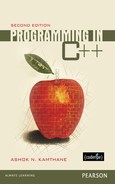Contents
1.1 Differences between C and C++
1.4 The Object Oriented Technology
1.5 Disadvantage of Conventional Programming
1.7 Preface to Object Oriented Programming
1.8 Key Concepts of Object Oriented Programming
1.10 Object Oriented Languages
2.2 Steps to Create and Execute a C++ Program
2.3 Flowchart for Creating a Source File, Compiling, Linking and Executing in C++
2.5 Typical C++ Environment (Borland C++)
2.6 Structure of a C++ Program
2.7 Illustrative Simple Program in C++ without Class
2.8 Header Files and Libraries
3.2 Streams in C++ and Stream Classes
3.6 Formatted and Unformatted Data
3.7 Unformatted Console I/O Operations
3.8 Type Casting with the cout Statement
3.9 Member Functions of the istream Class
3.10 Formatted Console I/O Operations
3.14 User-defined Manipulators
3.15 Manipulator with One Parameter
3.16 Manipulators with Multiple Parameters
4.3 Variable Declaration and Initialization
4.8 Memory Management Operators
4.11 Comma in Place of Curly Braces
5.7 Unconditional Control Transfer Statements
6.7 The do-while Statement with while Loop
7.6 Returning More Values by Reference
7.9 Inputting Default Arguments
7.12 Principles of Function Overloading
7.13 Precautions with Function Overloading
8.9 Access Specifiers and Their Scope
8.10 Defining Member Functions
8.11 Characteristics of Member Functions
8.12 Outside Member Function as Inline
8.13 Rules for Inline Functions
8.14 Data Hiding or Encapsulation
8.15 Classes, Objects, and Memory
8.20 Objects as Function Arguments
8.22 The const Member Functions
8.23 The Volatile Member Function
8.24 Recursive Member Function
8.26 empty, static, and const Classes
8.27 Member Function and Non-member Function
8.28 The main() Function as a Member Function
8.29 Overloading Member Functions
8.30 Overloading main() Functions
8.31 The main(), Member Function, and Indirect Recursion
9. Constructors and Destructors
9.2 Constructors and Destructors
9.3 Characteristics of Constructors and Destructors
9.4 Applications with Constructors
9.5 Constructors with Arguments (Parameterized Constructor)
9.6 Overloading Constructors (Multiple Constructors)
9.7 Array of Objects Using Constructors
9.8 Constructors with Default Arguments
9.12 Calling Constructors and Destructors
9.13 Qualifier and Nested Classes
9.15 Private Constructors and Destructors
9.16 Dynamic Initialization Using Constructors
9.17 Dynamic Operators and Constructors
9.18 main() as a Constructor and Destructor
9.20 Program Execution Before main()
9.21 Constructor and Destructor with Static Members
9.22 Local Versus Global Object
10. Operator Overloading and Type Conversion
10.3 Overloading Unary Operators
10.5 Constraint on Increment and Decrement Operators
10.6 Overloading Binary Operators
10.7 Overloading with friend Function
10.8 Overloading Assignment Operator (=)
10.10 Rules for Overloading Operators
10.11 One-Argument Constructor and Operator Function
10.12 Overloading Stream Operators
11.3 Access Specifiers and Simple Inheritance
11.4 Protected Data with Private Inheritance
11.13 Constructors, Destructors, and Inheritance
11.14 Object as a Class Member
11.16 Qualifier Classes and Inheritance
11.17 Constructors in Derived Class
11.18 Pointers and Inheritance
11.19 Overloading Member Function
11.20 Advantages of Inheritance
11.21 Disadvantages of Inheritance
12.2 One-dimensional Array Declaration and Initialization
12.3 Characteristics of Arrays
12.4 Accessing Array Elements Through Pointers
12.6 Passing Array Elements to a Function
12.7 Passing Complete Array Elements to a Function
12.8 Initialization of Arrays Using Functions
12.10 Pointers and Two-dimensional Arrays
12.11 Three- or Multi-dimensional Arrays
13.4 Arithmetic Operations with Pointers
13.11 Pointer to Derived Classes and Base Class
13.13 Accessing Private Members with Pointers
13.14 Direct Access to Private Members
13.15 Addresses of Objects and void Pointers
14.3 Dynamic Memory Allocation
14.4 The new and delete Operators
14.6 Overloading new and delete Operators
14.7 Overloading new and delete in Classes
14.8 Execution Sequence of Constructor and Destructor
14.9 Specifying Address of an Object
15. Binding, Polymorphisms, and Virtual Functions
15.3 Pointer to Base and Derived Class Objects
15.5 Rules for Virtual Functions
15.9 Working of Virtual Functions
15.10 Virtual Functions in Derived Classes
15.12 Constructors and Virtual Functions
15.14 Destructors and Virtual Functions
16.7 File Pointers and Manipulators
16.8 Manipulators with Arguments
16.12 Error Handling Functions
16.15 Sending Output to Devices
17. Generic Programming with Templates
17.3 Definition of Class Templates
17.4 Normal Function Templates
17.5 Working of Function Templates
17.6 Class Templates with More Parameters
17.7 Function Templates with More Arguments
17.8 Overloading of Template Functions
17.9 Member Function Templates
17.10 Recursion with Template Functions
17.11 Class Templates with Overloaded Operators
17.12 Class Templates Revisited
17.13 Class Templates and Inheritance
17.14 Bubble Sort Using Function Templates
17.15 Guidelines for Templates
17.16 Differences Between Templates and Macros
17.17 Linked Lists with Templates
18.2 Moving From C String to C++ String
18.3 Declaring and Initializing String Objects
18.7 Accessing Elements of Strings
19.2 Principles of Exception Handling
19.3 The Keywords try, throw, and catch
19.4 Guidelines for Exception Handling
19.5 Multiple catch Statements
19.6 Catching Multiple Exceptions
19.9 Exceptions in Constructors and Destructors
19.10 Controlling Uncaught Exceptions
19.11 Exceptions and Operator Overloading
19.12 Exceptions and Inheritance
19.13 Class Templates with Exception Handling
19.14 Guidelines for Exception Handling
20. Overview of Standard Template Library
21. Additional Information about ANSI and TURBO-C++
21.3 New Type-casting Operators
21.11 The Standard Namespace std
21.12 ANSI and Turbo-C++ Keywords
21.13 ANSI and Turbo-C++ Header Files
22.3 Video Display and Display Adapters
22.4 Initilisation of Graphics
22.5 Few Additional Graphics Functions
22.6 Programs Using Library Functions
22.8 Filling Patterns with Different Colors and Styles
